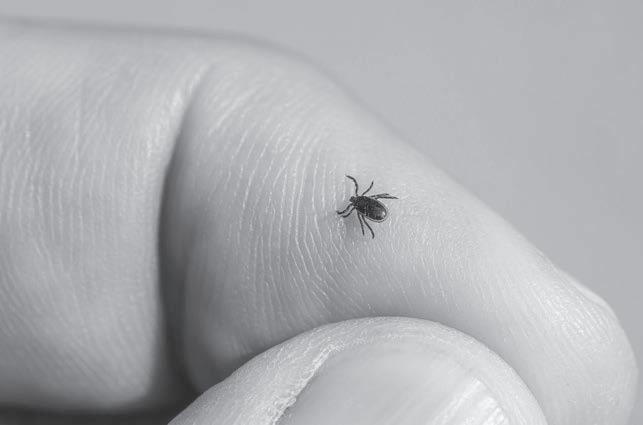
4 minute read
Ticks Are Out in Force — Stay Informed and Protect Yourself
by Brenda Malinics, for the Shuttle
The sight of ticks sends shivers and chills, quite literally, down the spines of many. Despite how tiny they are, they are deadly, and no one should let their guard down after being outdoors.
Lyme disease, the best-known disease caused by the blacklegged or deer tick, reached a near high level in Pennsylvania by the end of March —much earlier than previous years. According to the state’s Tick Research Lab, reports of dog tick bites were in the “mild” category and for Lone star ticks, “mild to low.”
Forecasters estimated that there would be a big increase in the tick population this year due to our mild winter. Ticks are most active from April through October, and the Centers for Disease Control reports that the Pennsylvania Department of Health has seen a 20% increase in tick-borne diseases, including babesiosis, in the past 12 years. A new virus, Powassan, has also been expanding.
Babesiosis, which is caused by microscopic parasites like the deer tick that infect red blood cells, is an emerging infection of concern. Symptoms are similar to Lyme disease and include fever, chills, sweats and fatigue and can begin about a week after a tick bite. It takes 36-48 hours for the Lyme disease bacterium to be transmitted to a human. If left untreated, either disease can spread to the joints, heart and nervous system and be debilitating, even fatal.
There is another scary emerging virus, the Deer Tick virus. It’s a type of Powassan virus which has been rare in the United States up to now, but the state Department of Environmental Protection has reported an increase in cases. This virus can be transmitted in as little as 15 minutes after a tick bite, and there are currently no vaccines to prevent it. Initial symptoms include fever, headache, vomiting and weakness. Some people show no symptoms, yet others can experience encephalitis or meningitis and require hospitalization. Other symptoms include mental confusion, loss of coordination, seizures and difficulty speaking. Half of the people who experience severe symptoms of Powassan suffer long-term negative health effects.
Lyme disease can sometimes be detected by the presence of a rash, but not all bites result in in the classic “bullseye.” I stopped counting how many times I have had Lyme disease about the sixth time I contracted it, and only once did I get a rash. On some occasions, when I found an embedded tick, I began taking antibiotics and other times I knew I had Lyme disease, even though I never saw a tick or found a bite. Ticks have a protein in their saliva that numbs the area they are biting, so unlike mosquito bites, which you feel, a person is unaware when a tick is chewing into their body
When the short-lived Lyme disease vaccine came out about 20 years ago, I was one of the first to line up to get it because I was working so closely with wildlife and domestic animals. The vaccine was later taken pulled off the market, but because I have had Lyme disease, I always test positive because I have the titers in my blood.
Tackling a Tough Invader
I still spend a lot of time outdoors, work with animals and consider myself hypervigilant in protecting myself against tick invaders, but they still manage to find and bite me. I wear tick gaiters when I walk in the woods. I use insect repellents. I change my clothing when I come indoors. I shower and scrub after being outdoors. I carry a tick remover on my keychain and am always checking myself for ticks. Recently, I found a nymph embedded in my thigh; it was the size of a grain of pepper. Nymphs can also carry the virus.
Here's the standard advice for avoiding ticks:
● Use a disinfectant containing DEET
● Wear light clothing
● Tuck your pants into your socks.
He’s Helping Pave the Way for Our New Store
(Continued from Page 1) at times overwhelming and intimidating. Thankfully, the board was (and still is!) comprised of cool cats who support all new board members and their learning curves.
● Wear gaiters or duct tape your pants tightly around your legs.
● Stay on clear paths and avoid tall, grassy areas.
● When you come indoors, change your clothing. Then shower and scrub every inch of your body and carefully check your front and back, groin and behind your knees and ears.
If you find a tick, avoid handling it with bare hands. Wear gloves and use a tick removal device so as not to leave any parts behind. Disinfect the bite area with alcohol, iodine and soap and water. I crush the ticks with a rock (they can withstand a flush down the toilet). Then call your doctor and ask about next steps.
Unless you never go outside, expect to encounter a tick somewhere, sometime on your body. They can even blow in the wind. I am still trying to figure out their purpose on our planet other than being a favorite snack of the opossum and guinea fowl (that’s another reason to be happy the next time you see a possum in your yard). Have a happy, safe, tick-free summer!
In case you haven’t pored over the seven Cooperative Principles lately, here’s a refresher:
1) Voluntary and Open Membership
2) Democratic Member-Owner Control
3) Member Economic Participation
4) Autonomy and Independence
5) Education, Training and Information

6) Cooperation among Cooperatives
7) Concern for Community
Our work to establish the Germantown store has me referring to these principles often. Each Weavers Way location occupies its own place in its neighborhood. Early on, during a Germantown outreach call, a concerned neighbor (and Co-op member) said, “You realize that many families in Germantown do all of their grocery shopping at the dollar store.” Principle Three (Member Economic Participation) requires that we consider this comment when planning the new store, in part because of Principle Seven (Concern for Community).
Principle One, Voluntary and Open Membership, means we cannot rely alone on the existing base of members we already have in Germantown (which is the largest outside of Mt. Airy and Chestnut Hill). Rather, we have to fully embrace Principle Five, (Education, Training and Information) by educating our community — and more importantly, ourselves — about who we are. We must continue to address the systemic inequities that have shaped where we are today and embrace difficult







